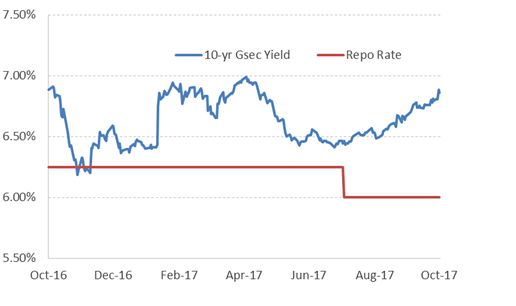Debt funds have been feeling the heat lately, especially those betting on medium to long-term papers. As you know, bond yields and bond prices share an inverse relation. And in the recent times, long term bond yields, guided by the movement of 10-year G-Sec, have been rising steadily. The primary reason for this shift is unlikeliness of RBI slashing policy rates further.
How the Yields are trending?

Moreover, during the first half of FY 2017-18; India's fiscal deficit has touched 91% of the full years' threshold. These two factors in conjunction don't bode well for the future of long duration bond funds.
Mr Kumaresh Ramakrishnan, Head of Fixed Income at DHFL Pramerica Mutual Fund explained the strategy of his fund house. "We have reduced our duration by three-four years in the medium- and long-term funds to tide over the volatility in the short term."
"The interest rate trajectory is a bit uncertain now, with many participants saying that the low-rate cycle would end soon. Investors should shift to shorter-maturity funds from long ones”, he added further.
Expressing contrasting view, Ms Lakshmi Iyer, chief investment officer (debt), Kotak Mutual Fund said, "We have not yet entered the rate tightening zone.” And added further that, "Investors who have not completed three years of investment in medium-to-long-term funds should stay put as there is a limited possibility for yields going up from current levels. Those debt schemes are still yielding at least 100 basis points higher than similar-maturity bank deposits annually since the past three-four years."
How various categories of debt funds have fared?

1-year above returns are compounded annualised. The rest are the absolute.
Data as on November 03, 2017
(Source: ACE MF, PersonalFN Research)
Returns generated by the schemes focused on the long end of the yield curve have been rather volatile. In contrast, schemes with a shorter duration portfolio have shown consistency in generating returns.
What to expect?
Currently, the Monetary Policy Committee (MPC) has decided to keep the policy stance ‘neutral’ and closely monitor the incoming data. Further, the MPC remains committed to keeping headline inflation close to 4.00% on a durable basis. The Reserve Bank also aims to work towards the resolution of stressed corporate exposures in bank balance sheets, which it expects would start yielding dividends for the economy over the medium term. Since banks haven’t completely passed on the benefit of policy rate cuts to borrowers, RBI is unlikely to lower policy rates unless, retail inflation falls below 2% or GDP growth falls sharply.
During such times, first selecting the category of debt mutual funds becomes crucial.
What investors should do at this juncture?
PersonalFN is of the view that, investing aggressively at the longer end of the yield curve could prove imprudent. To put it simply, investing in long-term debt funds (holding longer maturity debt papers) can be perilous, since most of the rally has been captured already at the longer end of the yield curve and there’s not much steam left. So, preferably, invest vide dynamically managed bond funds (with an investment time horizon of 2-3 year). It is a prudent approach.
You’ll also be better-off if you deploy your hard-earned money in short-term debt funds. Just ensure you’re giving due importance to your investment time horizon, asset allocation and diversification. Consider investing in short-term debt funds for an investment horizon of upto 2 years.
If you have an investment horizon of 3 to 6 months, ultra-short term funds (also known as liquid plus funds) would be the most suitable.
And if you have an extreme short-term time horizon (of less than 3 months), you would be better-off investing in liquid funds.
Don’t forget that investing in debt funds is not risk-free. Therefore, consider the five facets before investing in debt funds.
Some other options to invest in debt instruments are tax-free bonds; especially if you are in the highest tax bracket and able to subscribe to the bonds in the primary market (as and when they are offered). Currently, there are no tax-free bond available for subscription in the primary market. With the financial year drawing to a close, you may find quite a few.
A few highly rated corporate deposits and bonds may also yield better returns than bank FDs. But make sure you study the company’s financials before investing, as the risk of default can’t be ignored. This will save you from the financial shocks.
A sensible and astute investment strategy serves the path to wealth creation and is always healthy for your long-term financial wellbeing.
Add Comments